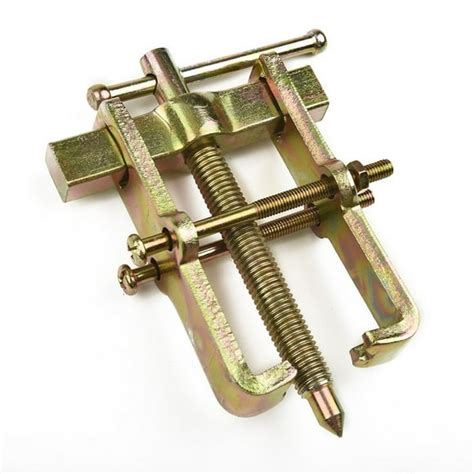The Ultimate Guide to Needle Bearing Pullers: Unleashing Precision and Efficiency
In the realm of precision engineering, needle bearing pullers stand as indispensable tools for seamless assembly and disassembly. These specialized devices empower technicians to effortlessly remove and install needle bearings, a crucial component in countless industrial applications.
Understanding Needle Bearings and Their Applications
Needle bearings are cylindrical rollers with a small diameter and high length-to-diameter ratio. Their compact design allows for high load capacities within a limited space, making them ideal for applications where space constraints are a concern. Needle bearings find widespread use in various industries, including automotive, aerospace, medical equipment, and manufacturing.
Benefits of Using Needle Bearings
-
High load capacity: Needle bearings can withstand substantial loads due to their large contact surface area.
-
Low friction: Their cylindrical shape and smooth surfaces minimize friction, resulting in reduced power loss and improved efficiency.
-
Compact size: The small diameter of needle bearings allows for their use in applications where space is limited.
-
High speed capability: Needle bearings can operate at high speeds without compromising performance or reliability.
The Essential Role of Needle Bearing Pullers
Needle bearing pullers play a vital role in the maintenance and repair of equipment utilizing needle bearings. These devices provide a safe and efficient means of removing and installing needle bearings, ensuring proper functioning and extending equipment lifespan.

Types of Needle Bearing Pullers
Various types of needle bearing pullers are available, each tailored to specific applications. Common types include:

-
Manual pullers: Operated manually using leverage, suitable for light-duty applications.
-
Hydraulic pullers: Utilize hydraulic pressure for effortless removal and installation, ideal for heavy-duty applications.
-
Mechanical pullers: Use mechanical force to remove bearings, offering a versatile option for various applications.
Effective Strategies for Needle Bearing Puller Usage
-
Choose the right puller: Select the puller type and size appropriate for the needle bearing and application requirements.
-
Secure the workpiece: Ensure the workpiece is securely fastened to prevent movement during the pulling process.
-
Position the puller: Carefully position the puller's jaws on the needle bearing, ensuring proper alignment.
-
Apply force evenly: Gradually apply force to the puller, avoiding sudden jerks or excessive pressure.
-
Inspect the bearing: Once the bearing is removed, inspect it for any damage or wear.
Tips and Tricks for Optimal Performance
-
Use a lubricant: Apply a thin layer of lubricant to the bearing and puller jaws to reduce friction and prevent damage.
-
Protect the workpiece: Use a soft cloth or protective material to cover the workpiece surface and prevent scratches.
-
Handle with care: Handle the needle bearing and puller with care to avoid damage or injury.
-
Clean the tools: Regularly clean the puller and accessories to ensure optimal performance and prevent contamination.
Common Mistakes to Avoid
-
Overtightening: Avoid excessive force on the puller, as it can damage the bearing or puller.
-
Misalignment: Improper alignment of the puller's jaws can lead to uneven force distribution and damage.
-
Using the wrong puller: Selecting an inappropriate puller can result in difficulty or damage during the pulling process.
-
Ignoring safety precautions: Always wear appropriate safety gear and follow the manufacturer's instructions for safe operation.
Table 1: Needle Bearing Puller Types and Applications
| Puller Type |
Application |
| Manual Puller |
Light-duty applications, such as small engines or appliances |
| Hydraulic Puller |
Heavy-duty applications, such as industrial machinery or automotive components |
| Mechanical Puller |
Versatile option for various applications, such as bearing removal from shafts or housings |
Table 2: Needle Bearing Puller Selection Criteria
| Factor |
Consideration |
| Bearing Size |
Diameter and length of the needle bearing |
| Workpiece Material |
Hardness and surface condition |
| Application |
Load capacity and speed requirements |
| Space Constraints |
Limited space availability |
Table 3: Safety Precautions for Using Needle Bearing Pullers
| Precaution |
Description |
| Wear Safety Gear |
Protect eyes, hands, and body from potential hazards |
| Follow Instructions |
Read and adhere to the manufacturer's instructions for safe operation |
| Avoid Overtightening |
Excessive force can damage the bearing or puller |
| Secure the Workpiece |
Ensure the workpiece is securely fastened to prevent movement |
| Inspect Tools Regularly |
Check puller and accessories for damage or wear before use |
Humorous Stories and Lessons Learned
Story 1: A technician attempting to remove a needle bearing from a shaft used excessive force and snapped the puller's jaws. The lesson learned: always choose the right puller and apply force gradually.
Story 2: During the installation of a needle bearing, a technician misaligned the puller's jaws, causing the bearing to become wedged in the housing. The lesson learned: ensure proper alignment of the puller before applying force.

Story 3: A team of mechanics was struggling to remove a needle bearing from a gearbox. After hours of failed attempts, they realized that the puller was too small for the bearing. The lesson learned: select the correct puller size for the job.
Conclusion
Needle bearing pullers are indispensable tools in the maintenance, repair, and assembly of equipment utilizing needle bearings. By understanding the different types, applications, and best practices for using needle bearing pullers, you can ensure precision, efficiency, and optimal performance in your projects. Embrace the power of these specialized tools to unlock new possibilities and elevate your engineering capabilities.
Return to Top

